The Awsc Post
-
- A New Course For AWO's Shipyard Conference Maritime Reporter, Aug 1990 #36
A conscious decision to expand the activities of the American Waterways Shipyard Conference was made by the conference members on March 10, 1989, so that our nation's small and medium-sized shipyards could strengthen their voice in Washington. To achieve that goal, AWSC increased the size and responsibility of the conference staff with the clear intent of working toward increasing activities and expanding membership in the organization.
In June of 1989, AWSC hired a new director, and in August, a permanent, full-time assistant to the director was hired. Conference members voted to increase their assessments in order to adequately fund the new commitment to a more active organization.
To better reflect the Conference's new direction, members completely restructured AWSC's committees as follows: Regulatory Committee—to analyze federal regulations and develop appropriate responses to regulatory proposals, with emphasis on proposals by Coast Guard, OSHA, EPA, and SBA.
Legislative Committee—to analyze legislative proposals and develop appropriate responses to those proposals; Membership and Member Services Committee—to concentrate on member recruiting and retention, as well as oversee present AWSC services and develop new services; and, Military and Government Contracts Committee—to focus on expanding AWSC's role in assisting members who repair and construct government vessels, as well as to seek new opportunities for small and medium-sized shipyards in the area of government contracts.
AWSC set as a top priority spreading the word about all that AWSC has to offer both current and prospective members. An undeniable challenge is expanding membership.
Of over 300 small and medium- sized shipyards located throughout the country, only about 20 percent enjoy the benefits of being represented by a Washington, D.C.-based organization established to respond to their needs.
Among prospective members there is a common misconception that AWSC exclusively represents small shipyards involved in the construction and repair of tugboats and barges. There is little understanding of the diversity of the work done by conference members.
Few realize that several AWSC members are small repair shipyards affiliated with much larger shipyards capable of building huge government and commercial vessels.
Because of their smaller size and the kind of work they do, however, they share many of the concerns of the other small and medium-sized yards which make up the conference membership. The conference represents shipyards presently constructing both oceangoing barges and inland hopper barges. Several members are converting offshore supply vessels to fish processing vessels and dinner cruise vessels. Other shipyards concentrate strictly on the repair and construction of fishing vessels, while still others concentrate on passenger vessels and yachts.
Many AWSC members are becoming increasingly involved in government work, building and repairing vessels for the Coast Guard, Corps of Engineers, MarAd, NOAA, and the Navy. Several shipyards are not involved in construction at all.
Some of these members focus on topside repairs; some are primarily gas-freeing and tank-cleaning facilities.
The common threads which bind together this group are their commitment to AWSC and AWO, and their desire to participate actively in the decision-making process in Washington, one which is often too cumbersome for the small businessman to influence alone. The shipyards are strong. They have survived the severe depression of the mid-1980s, and are slowly beginning to feel the recovery.
All in all, this adds up to an industry association that is extremely diversified in its individual members' operations, but uniquely unified in its mission: to promote, protect and defend the small to medium-sized shipyard industry.
In the last year, 58 shipyards in New York, Virginia, Mississippi, Louisiana, Texas, Washington, and California were visited by conference staff. In those visits, it became clear that the conference enjoys strong support from its members, and of those prospective members visited, it was obvious that most appreciated and understood the need to belong to a national trade association representing the interests of their industry.
Commensurate with reaching out to current and prospective members, AWSC has now completed the task of computerizing the database of the conference's Annual Shipyard Survey, assuring the accuracy of the results and greatly improving the efficiency of publishing those results.
The conference is also exploring the development of an insurance program to assist members in addressing the growing cost of USL&H Compensation Act coverage; the possibility of developing a guide to assist members in meeting the quality assurance demands of their customers; and, the publication of a national shipyard directory to provide the marine industry with a comprehensive guide to shipyards capable of meeting its needs.
In addition to these expanded and improved member services, AWSC has stepped up its activity in legislative and regulatory issues. On the legislative front, the opposition to efforts to weaken the Jones Act continues to dominate the agenda.
Development of environmental issues must be monitored, and their impact on the shipyard industry must be defined as these issues are developed.
On the regulatory front, the Coast Guard's efforts to adopt the International Guide for Safety of Oil Tankers and Terminals (ISGOTT) as domestic regulation controlling any facility involved in tank-cleaning and gas-freeing operations must be defeated. AWSC has developed a safety manual for these operations which better address the Coast Guard's concerns and more adequately relate to our domestic industry.
In addition, new measurement regulations intended to implement the International Convention on Tonnage Measurement have added about $1,000 per vessel to the costs of constructing new domestic barges. AWSC has secured immediate changes in the new procedure which reduces the costs in the short term, but must seek a permanent statutory solution. Staff changes at OSHA have slowed the work of its Shipyard Employment Standards Advisory Committee and the development of vertical standards. The conference has been working on this for several years, and must insist that this work continue.
Finally, AWSC has joined in a lawsuit seeking to reverse the Coast Guard's interpretation of the American ownership provisions of the Anti-Reflagging Act of 1987. The Coast Guard's decision would allow any vessel engaged in our domestic fishing industry prior to the Act's cutoff date to be sold to a foreign entity without losing its domestic trading privilege. This interpretation completely undermines the intent of Congress to Americanize our domestic fishing fleet.
The new AWSC has evolved into a stronger, more active organization representing the interests of our nation's small and medium-sized shipyards.
The conference offers valuable member services and the opportunity for its members to actively participate in decisions which could impact their bottom line. Now the key rests in continuing to build a stronger membership and then a stronger industry. Of course, the conference's efforts to expand can only succeed with the continued and enthusiastic support of the general membership of AWO. • *Editor's Note: On June 21, the American Waterways Shipyard Conference appointed Robert F. O'Neill as the new director, AtVSC. Mr. O'Neill replaces Cornel Martin.
who served in the AWSC post for one year, and who is now AWO's vice president- Southern Region.
Mr. O'Neill has over a decade of experience on Capitol Hill, having served as a professional staff member to the House Subcommittee on Science, Research and Technology since 1982. Prior to that, he acted as a legislative assistant to Representative Doug Walgren, and as a political consultant. He served in the military in the U.S. Air Force Intelligence Service.
Mr. O'Neill is a graduate of Wheeling Jesuit College.
-
 )
March 2024 - Marine Technology Reporter page: 37
)
March 2024 - Marine Technology Reporter page: 37miscible barrier ? uid heavier than seawater (sg=1.026) and lighter than the battery electrolyte (sg=1.265). The original cell vent cap was screwed into the top of the riser pipe to vent the gases associated with charging. Wires were soldered to the lead (Pb) posts. The lead-acid battery was additionall
-
 )
March 2024 - Marine Technology Reporter page: 11
)
March 2024 - Marine Technology Reporter page: 11assist in identifying mines and act as a neutralization device. About the Author Bottom mines pose even greater chal- David R. Strachan is a defense analyst and founder of lenges. Unlike contact mines, bottom Strikepod Systems, a research and strategic advisory mines utilize a range of sensors to
-
 )
March 2024 - Marine Technology Reporter page: 9
)
March 2024 - Marine Technology Reporter page: 9from marinas along the western coast. The exact number of lizing laser detection systems can detect mines just below the mines, as well as their locations, remains largely a mystery, surface, even those hiding in murky water. The Airborne Laser although reports suggest that over three hundred have been
-
 )
March 2024 - Marine Technology Reporter page: 4
)
March 2024 - Marine Technology Reporter page: 4Editorial NIWA-Nippon Foundation TESMaP/ Rebekah Parsons-King www.marinetechnologynews.com ast month marked the resounding NEW YORK 118 E. 25th St., New York, NY 10010 return of Oceanology Interna- Tel: (212) 477-6700; Fax: (212) 254-6271 tional in London, perennially one Lof the world’s most important
-
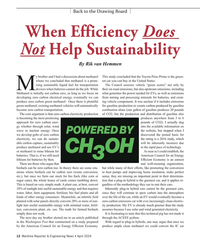 )
April 2024 - Maritime Reporter and Engineering News page: 12
)
April 2024 - Maritime Reporter and Engineering News page: 12Back to the Drawing Board When Efficiency Does Not Help Sustainability By Rik van Hemmen y brother and I had a discussion about methanol This study concluded that the Toyota Prius Prime is the green- where we concluded that methanol is a prom- est car you can buy in the United States. ising sustainable
-
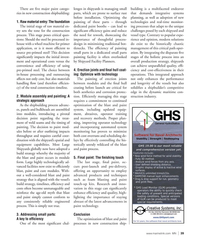 )
April 2024 - Marine News page: 39
)
April 2024 - Marine News page: 39There are ? ve major paint catego- lenges in shipyards is managing small building is a multifaceted endeavor ries in new construction shipbuilding: parts, which are prone to surface rust that demands integrative systems before installation. Optimizing the planning, as well as adoption of new 1.
-
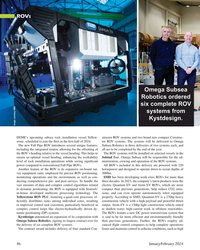 )
January 2024 - Marine Technology Reporter page: 46
)
January 2024 - Marine Technology Reporter page: 46courtesy SMD DEME’s upcoming subsea rock installation vessel Yellow- structor ROV systems and two brand new compact Construc- stone, scheduled to join the ? eet in the ? rst half of 2024. tor ROV systems. The systems will be delivered to Omega The new Fall Pipe ROV introduces several unique features,
-
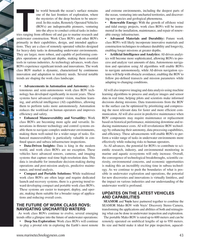 )
January 2024 - Marine Technology Reporter page: 43
)
January 2024 - Marine Technology Reporter page: 43he world beneath the ocean’s surface remains and extreme environments, including the deepest parts of one of the last frontiers of exploration, where the ocean, venturing into uncharted territories, and discover- the mysteries of the deep beckon to be uncov- ing new species and geological phenomena. ered.
-
 )
January 2024 - Marine Technology Reporter page: 4
)
January 2024 - Marine Technology Reporter page: 4Editorial bout 12 years ago I was invited to the home of then Chief of Naval Operations, Admiral Gary A Roughead, for “a discussion on unmanned underwater systems.” When I ? rst received the invite, my ? rst thought was © Jason Adelaars MBARI 2023 www.marinetechnologynews.com “how did I get on this
-
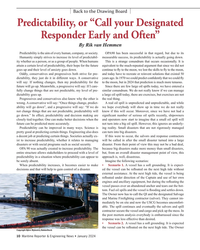 )
January 2024 - Maritime Reporter and Engineering News page: 10
)
January 2024 - Maritime Reporter and Engineering News page: 10Back to the Drawing Board Predictability, or “Call your Designated Responder Early and Often” By Rik van Hemmen Predictability is the aim of every human, company, or society. OPA90 has been successful in that regard, but due to its Humanity simply strives to increase its level of predictabil- measurable
-
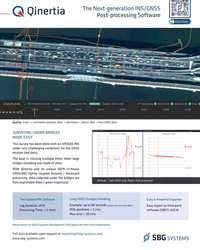 )
November 2023 - Marine Technology Reporter page: 5
)
November 2023 - Marine Technology Reporter page: 5The Next-generationINS/GNSS Post-processing Software Quality: Green -> centimetric position; Blue -> decimetric < 30cms; Red -> Raw GNSS data SURVEYING UNDER BRIDGES Å GNSS Altitude (m) - Merged Å Altitude (m) - Merged MADE EASY This survey has been done with an APOGEE INS under very challenging condition
-
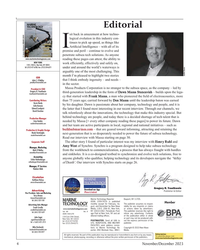 )
November 2023 - Marine Technology Reporter page: 4
)
November 2023 - Marine Technology Reporter page: 4promise and peril – continue to evolve and penetrate subsea tech solutions. As anyone © Jason Adelaars MBARI 2023 www.marinetechnologynews.com reading these pages can attest, the ability to NEW YORK work ef? ciently, effectively and safely on, 118 E. 25th St., New York, NY 10010 Tel: (212) 477-6700
-
 )
November 2023 - Maritime Reporter and Engineering News page: 21
)
November 2023 - Maritime Reporter and Engineering News page: 21the Supreme Court of the United States. Contained within the right to appeal to the Commandant is the safeguard that no Coast Guard person who investigated or prosecuted the case may participate or advise in the decision of the ALJ or of the Commandant. 33 C.F.R. § 20.206(b). Finally, the mariner
-
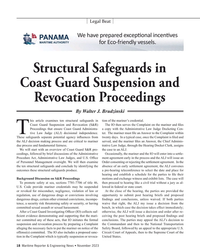 )
November 2023 - Maritime Reporter and Engineering News page: 18
)
November 2023 - Maritime Reporter and Engineering News page: 18Safeguards in Coast Guard Suspension and Revocation Proceedings By Walter J. Brudzinski his article examines ten structural safeguards in tion of the mariner’s credential. Coast Guard Suspension and Revocation (S&R) The IO then serves the Complaint on the mariner and ? les Proceedings that ensure
-
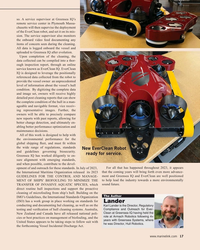 )
November 2023 - Maritime Reporter and Engineering News page: 17
)
November 2023 - Maritime Reporter and Engineering News page: 17so. A service supervisor at Greensea IQ’s remote service center in Plymouth Massa- chusetts will then supervise the deployment of the EverClean robot, and set it on its mis- sion. The service supervisor also monitors the onboard video feed documenting any items of concern seen during the cleaning.
-
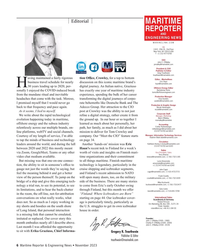 )
November 2023 - Maritime Reporter and Engineering News page: 6
)
November 2023 - Maritime Reporter and Engineering News page: 6.com H30 years leading up to 2020, per- digital journey. An Italian native, Graziuso Offshore Energy Editor Bartolomej Tomic sonally I enjoyed the COVID-induced break has exactly one year of maritime industry [email protected] from the mundane ritual and inevitable experience, spending
-
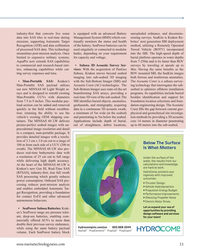 )
September 2023 - Marine Technology Reporter page: 33
)
September 2023 - Marine Technology Reporter page: 33in real-time during Management System (BMS) which con- sioning surveys. SeaKite is Kraken Ro- missions, supporting Automatic Target tinually monitors the status and health botics’ next generation SBI deployment Recognition (ATR) and data ex? ltration of the battery. SeaPower batteries can be method
-
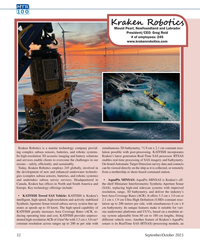 )
September 2023 - Marine Technology Reporter page: 32
)
September 2023 - Marine Technology Reporter page: 323D acoustic imaging and battery solutions Kraken’s latest generation Real-Time SAS processor. RTSAS and services enable clients to overcome the challenges in our enables real-time processing of SAS imagery and bathymetry. oceans – safely, ef? ciently, and sustainably. On-board Automatic
-
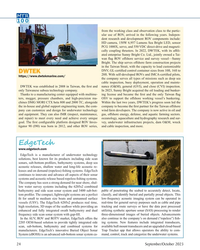 )
September 2023 - Marine Technology Reporter page: 24
)
September 2023 - Marine Technology Reporter page: 24MTR 100 from the working class and observation class to the partic- ular use of ROV, arrived in the following years. Indepen- dent research and development ROV components include: HD camera, 150W 6,957 Lumens Sea Bright LED, sensor PCG 1000X, servo, and 550 VDC direct-drive and magneti- cally coupling
-
 )
September 2023 - Marine Technology Reporter page: 4
)
September 2023 - Marine Technology Reporter page: 4MTR 100 Editorial www.marinetechnologynews.com th he 18 Annual MTR100 is brought to you again NEW YORK with the requisite amount of work that never seems 118 E. 25th St., New York, NY 10010 to lighten in the least, keeping on top of the people, Tel: (212) 477-6700; Fax: (212) 254-6271 Tcompanies and
-
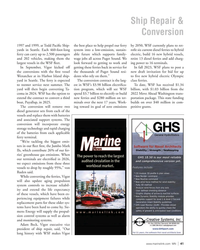 )
October 2023 - Marine News page: 41
)
October 2023 - Marine News page: 41Ship Repair & Conversion 1997 and 1999, at Todd Paci? c Ship- the best place to help propel our ferry by 2050, WSF currently plans to ret- yards in Seattle. Each 460-foot-long system into a low-emission, sustain- ro? t six current diesel ferries to hybrid ferry can carry up to 2,500 passengers able
-
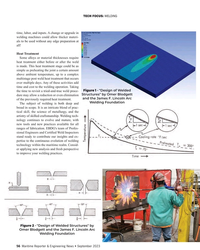 )
September 2023 - Maritime Reporter and Engineering News page: 56
)
September 2023 - Maritime Reporter and Engineering News page: 56allow thicker materi- als to be used without any edge preparation at all! Heat Treatment Some alloys or material thicknesses require heat treatment either before or after the weld is made. This heat treatment stage could be as simple as preheating the joint a certain amount above ambient temperature
-
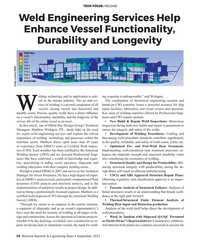 )
September 2023 - Maritime Reporter and Engineering News page: 54
)
September 2023 - Maritime Reporter and Engineering News page: 54, Durability and Longevity Image courtesy EBDG elding technology and its application is criti- ing expertise is indispensable," said Wichgers. cal to the marine industry. The art and sci- The combination of theoretical engineering acumen and ence of welding is a pivotal component of all hands-on CWI
-
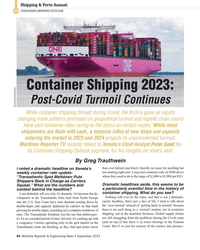 )
September 2023 - Maritime Reporter and Engineering News page: 44
)
September 2023 - Maritime Reporter and Engineering News page: 44CONTAINER SHIPPING OUTLOOK Container Shipping 2023: Post-Covid Turmoil Continues ©eyewave/AdobeStock While container shipping thrived during Covid, the thrill is gone as rapidly changing trade patterns premised on geopolitical turmoil and logistic chain snarls have sent container rates racing to the
